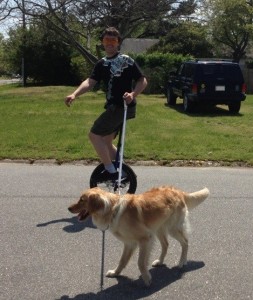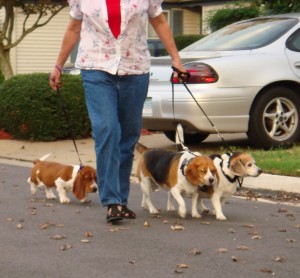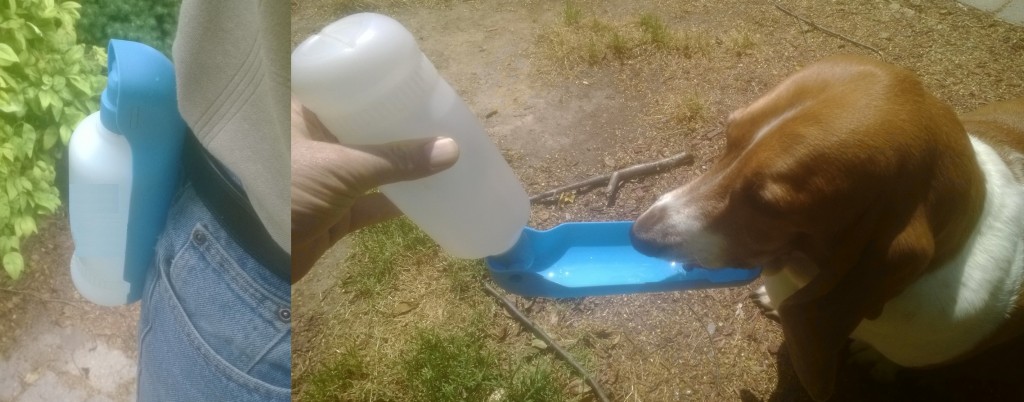Walking and running with dogs
Original article by S. Veigel May 20, 2014

Remember: Just a 20 minute walk around the block 3 times a week can reduce stress and improve appetite, mental clarity, behavior and general health. And it works for your dog too.
When I first wrote this article I was trying to address the average dog owner. You know, the dogs that aren’t trained for distance. I was trying to bring attention to the lack of attention we often give our dogs when we are focused on where we are going and what we are thinking about. And I wanted to speak to multiple dog owners who pace their walks on a hot day with the long legged dog while the short legged dogs are running to keep up. I mentioned the guy I saw in jogging shorts and tennis shoes running backwards jerking the leash of a dog that was obviously in distress. The guy walking briskly along with his dog limping behind him and the two poodles where one was being dragged from behind and working his little legs off to keep up. And yes, I may have knit picked a little on the guy jogging with a dog on 3 inch legs.
Ok, so yes dog sled dogs go 30 miles a day and in the competition called the “Iditarod” they pull sleds at a quick pace for 8 to 12 days (with 24 and 8 hour rest requirements at check points). And yes there are dogs who can run 20 miles. But let’s get some things straight.
First of all dog sled dogs are not running “full speed” for 30 miles delivering the mail. It’s more of a quick pace often with short breaks. The “musher” actually has a brake on the sled to slow them down if they’re running too fast. Second of all they are not running in 90 degree weather. It’s more like 20 to 60 below zero Fahrenheit so keeping their core temperature down isn’t as critical as moving to keep warm. Third, dog sled dogs are fed a special diet several times a day; not just a bowl of kibble. Fourth, they are running on snow trails not clay soil, hard hot concrete and asphalt. Fifth, dog sled dogs have their dew claws removed as pups to prevent injury. Sixth, dog sled dogs are “conditioned” to run with the team. They’ve often had a total of a thousand miles of training exercise before the Iditarod competition. Seventh, not all dog sled dogs running in the Iditarod are the same at the finish as the ones who started. Furthermore, dogs do get injured and there have been a couple deaths.
The fact is that dog-like animals are “pack hunters” who don’t normally choose to run distance just for fun. They track, sprint, walk/sniff, sprint again and work as a team to out maneuver their prey. And most all domestic dogs are not “conditioned” for distance. You can, but it has to be done right. You can’t just suddenly grab your “couch potato” dog and decide to go jogging.
Dogs are loyal to the end. Survival for a dog means that it will keep up with the pack no matter what. There’s no yelling, “Wait a minute guys, I hurt myself”, they just keep going if at all possible, suffer in silence and lick their wounds later. And that means that you, as the leader, may think your dog is fine when it is actually struggling. You may be having a great time, but your dog is only good with it for just so long.
So once again, please look over this list just to see if there isn’t something you could be more aware of.
II: Things you can do for your friend
1]: Know your dog and the weather – observe:
1a): Different breeds are more susceptible to things like arthritis, Hip Dysplasia, Joint and knee problems. Your dog’s ability to walk or run any distance depends on age, health, how much regular exercise it gets, length and thickness of its fur, current temperatures and humidity.
1b): Remember: There’s a reason for the “Heat Index” (“Feels Like” Temperature). The higher the humidity the harder it is to stay cool. Dogs don’t sweat. If they can’t get enough cooling air in and out when they pant they can suffer heat stress, stroke and heart attack. Also your dog may have short fur but you need to pay attention to the thickness of the layers. Two short haired dogs may not have the same thickness and the one with thicker layers will suffer more.
1c): Think about what you’re asking your dog to do. Don’t make them sit or walk on hot asphalt or concrete (or even when freezing). If they’re half sitting on their back legs think about what they might be trying to tell you and how you would feel doing that with no protection on your body. Yes, they have fur, but that doesn’t cover everything. And they do pick up heat through their pads.
1d): Take some water with you for your dog on hot days. They’ll tell you if they need it when you offer it. Plan hot day runs or walks for the early morning or evening when it’s cooler. Watch for heavy panting and signs of fatigue. Give frequent breaks.
 1e): When walking multiple dogs pace your walk to the dog with the shortest legs. Really active breeds will do fine but others won’t. If you feel more of a pull behind you on one leash look, check for fatigue or limping (muscle soreness or sprain, burr or thorn in the paw, a cut on the pad). If one dog seems more tired, just take more breaks on the walk to let them sniff or rest in a shady spot.
1e): When walking multiple dogs pace your walk to the dog with the shortest legs. Really active breeds will do fine but others won’t. If you feel more of a pull behind you on one leash look, check for fatigue or limping (muscle soreness or sprain, burr or thorn in the paw, a cut on the pad). If one dog seems more tired, just take more breaks on the walk to let them sniff or rest in a shady spot.
1f): Don’t leave your dog in the car on a hot day for more than a couple of minutes. Remember, even with the windows left open slightly the dog has to pant to keep cool. There is no effective air movement and the rays of the sun shining in through the glass will rapidly heat the interior of the car along with your dog’s body. It makes your dog miserable at best, often ill and can kill your dog.
2]: Running with dogs:
2a): First, observe everything listed above.
2b): Check with your veterinarian before you plan running with your dog and frequently thereafter. Joint and knee problems can develop even if you’ve been running with your dog for some time. Remember, the dog will try to keep up regardless. It’s up to you to say, “Ok. That’s enough”.
2c): If you weren’t in shape you’d probably have severe pain trying to run distance from the start. Don’t ask your dog to do it. Have an exercise plan to help your dog build up to it.
2d): Yes, short legged dogs can go jogging with you IF they’re the correct breed. Just remember there’s a big difference between the energetic Jack Russell Terrier and a Basset Hound. Know your breed, ask your veterinarian for advice.
2e): There are dog running websites with some great information. Do a little research so you both have a wonderful experience.
